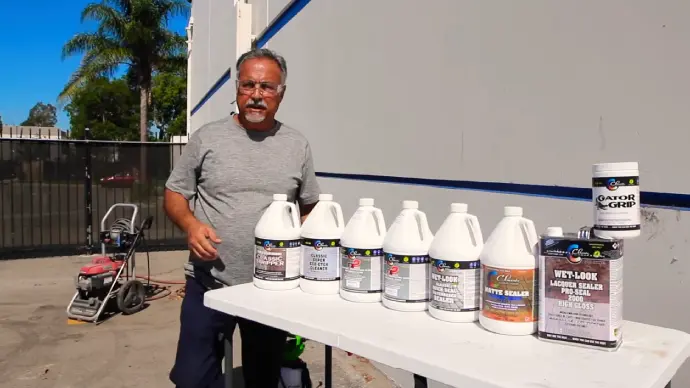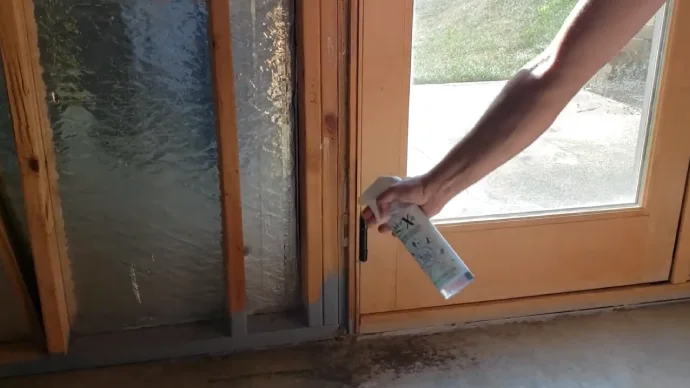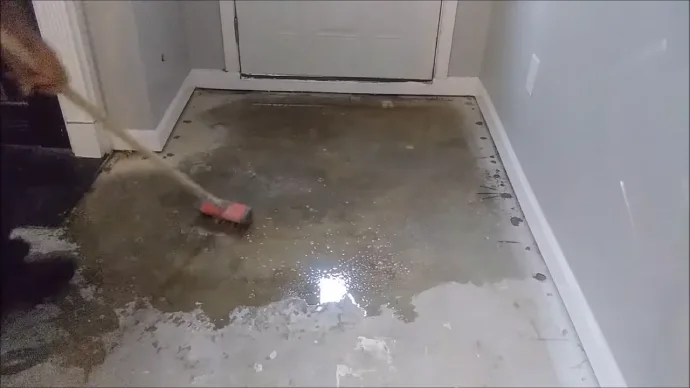Last Updated on February 6, 2023
When it comes to keeping your concrete surfaces looking their best, one of the most important things to consider is how to protect them from the damage that cat urine can cause. Cat urine contains a powerful and destructive chemical reaction when it comes into contact with cement in concrete and can weaken and discolor the surface if left unchecked.
Thankfully, there are a range of sealing solutions available for protecting concrete from cat urine damage all you need to do is understand the different types of sealers available and know how to apply them correctly. In this blog post, we’ll take a closer look at how these sealers work, what types are most effective, and the best practices for getting the job done right.
We’ll also explore other non-penetrating sealers you may want to consider, as well as offer tips on preparing and applying sealer properly so you can keep your concrete looking its best for longer.
A Closer Look at the Damage Caused by Cat Urine on Concrete
The Chemical Reaction of Urine with Cement in Concrete
When cat urine comes into contact with concrete, it causes a chemical reaction that can lead to significant damage. This is because the components of cat urine contain uric acid crystals, which are highly reactive and corrosive.
When these crystals come into contact with cement, they begin to break down its molecules and dissolve the calcium carbonate that forms the cement’s hard surface. As a result, the concrete begins to weaken and crumble, leading to cracks and holes in the surface.
In addition, cat urine contains nitrogen compounds that react with calcium hydroxide in cement, resulting in a whitish discoloration on the surface of the concrete.
How Urine Can Weaken and Discolor Concrete
The reaction between cat urine and concrete can cause both weakening and discoloration of the latter. As mentioned above, when uric acid crystals present in cat urine come into contact with cement, they start breaking down its molecules and dissolving its calcium carbonate content.
This leads to weakening of the material over time as it starts to crack or form holes. In addition, nitrogen compounds from cat urine also react with calcium hydroxide in cement to produce a white discoloration on its surface.
This discoloration is permanent as it cannot be removed by scrubbing or washing since it is caused due to a chemical reaction between two materials rather than dirt or staining from other sources.
The Need for Sealing Solutions to Protect Against Cat Urine Damage
Given that cat urine can cause significant damage to concrete surfaces via weakening and discoloring them beyond repair, it is important for owners of such surfaces – such as driveways, patios ect. to take preventive measures against this sort of damage.
One way homeowners can protect their concrete surfaces from being damaged due to exposure to cat urine is through sealing them using products designed specifically for this purpose. These sealants create an invisible barrier on top of concrete that prevents any liquids from reacting with its components and causing damage; however they should be regularly inspected for signs of wear or tear so that they are replaced before they become ineffective.
Homeowners should also keep cats away from areas where they might urinate on concrete surfaces if possible; however when this isn’t feasible other measures need to be taken such as installing synthetic turf or artificial grass instead as these materials are not affected by exposure to liquids like water or pet urine like natural turf does.
Understanding the Different Types of Sealers for Concrete

1. The Benefits of Using a Penetrating Sealer for Cat Urine Protection:
When it comes to protecting concrete from cat urine, one of the best options available is a penetrating sealer. These sealers coat and penetrate into the pores of the concrete, creating an impenetrable barrier that prevents liquid from seeping through and causing staining or other damage.
Not only do they protect against cat urine, but they also protect against oil, grease, water and other liquids that could potentially cause damage to the surface of the concrete. In addition to this protection, penetrating sealers also offer added benefits such as slip resistance and stain resistance, which are important features when dealing with pet traffic on a daily basis.
For these reasons, using a penetrating sealer is often recommended when it comes to protecting concrete surfaces from cat urine or other pet accidents.
2. Water-Based Acrylics vs Solvent-Based Acrylics:
When it comes to choosing the right sealer for your concrete surface, you may need to decide between a water-based acrylic or solvent-based acrylic sealer. Both types have their own advantages and disadvantages; however, one key factor to consider would be whether your concrete surface needs to breath or not.
A water-based acrylic is better suited for surfaces that require some breathability (like walls), while a solvent-based acrylic is better suited for surfaces that need more impermeability (like floors). Additionally, water based acrylics tend to provide a glossy finish compared to solvent based acrylics which typically offer more of a matte finish on concrete surfaces – this can be important if you want your floor looking nice after sealing it up!
Ultimately though, the type of sealer you choose should depend on both personal preference and the specific needs of your project – make sure you understand what your requirements are before making any final decisions here!
3. Epoxy Based Sealers as an Option for Heavy Traffic Areas with Cats:
When dealing with heavy pet traffic in areas frequented by cats, epoxy based sealers may be the best choice due to their superior levels of adhesion and abrasion resistance compared to other types of sealants such as latex or polyurethanes.
It’s important to note however that epoxies tend to be quite expensive so if cost isn’t an issue then epoxy may be worth considering as this type of sealant will certainly provide years of protection against cat urine stains in high traffic areas!
Additionally, epoxy based sealers can add some bitumen (or rubber) like qualities which increases footing traction in slippery areas – great if your cat likes running around all over during playtime!
4. Polyurethane Sealers as an Option for Low Traffic Areas with Cats:
If you don’t have many pets running around in low traffic areas then polyurethane may be worth considering since this type of coating offers great durability and protection against moisture without being too expensive either – making it ideal for smaller spaces like bathrooms or bedrooms where cats don’t typically spend much time outside playing around!
Additionally, polyurethane has good levels of stain resistance which makes it perfect for sealing up scratch marks left behind by playful kittens or cats who just enjoy lounging around inside all day long – meaning no more worries about unsightly marks ruining your newly renovated interiors!
5. Looking at Other Non Penetrating Concrete Sealers To Consider:
If neither penetrating nor non penetrating solutions seem like something suitable for your needs then there are still plenty more types out there worth considering like silicate densifiers which work by filling in the pores within concrete so liquids can’t seep through – perfect for countertops where spilling food or drinks is always expected! Or perhaps consider trying out reactive silicone which allows moisture vapor.
Transmission while simultaneously creating an impenetrable barrier against most common household chemicals making them great choices when dealing with busy kitchens full of curious kitties wanting explore every nook they can find! Ultimately though the best option will depend on how much wear & tear you expect from pet activity so make sure you understand exactly what type will fit best before making any final decisions here!
Preparing the Area and Applying the Sealer Properly to Protect Against Cat Urine Damage
Cleaning and Prepping the Area Before Sealing Begins
In order to protect against cat urine damage, it is essential to properly clean and prep the area before the sealing begins. This process should always start by thoroughly vacuuming the affected area to remove any loose particles of dirt, dust, pet hair, or other debris that can interfere with the sealing process.
After vacuuming, a high-power wet/dry vacuum cleaner can also be used for deep cleaning and removing any old sealers or residue left behind from previous sealer applications.
To further ensure proper adhesion of the new sealer, it is important to make sure all surfaces are completely dry before sealing begins. To achieve this goal, a fan can be placed in an adjacent room to help circulate air throughout the area. Additionally, a dehumidifier can be used as well to help eliminate moisture in hard to reach places.
Once all debris has been removed and all surfaces are dried out, any cracks or holes in concrete should be filled using an appropriate compound specifically designed for use with concrete surfaces. For more effective results, use a thin layer of patching material for areas no bigger than 1 square foot and let it completely dry before continuing on with the sealing process.
It is also important to keep in mind that any paint or coatings applied prior must be completely cured and hardened before applying any sealant over them; otherwise they will not provide proper protection against cat urine damage as intended.
Ensuring Proper Application of the Selected Sealer
To ensure proper application of the selected sealer when protecting against cat urine damage, it is important to follow manufacturer’s instructions carefully when selecting and using sealers designed for this purpose.
Before application begins, make sure that you select a sealer made specifically for pet urine protection and one that is compatible with your particular surface type (e.g., concrete).
Additionally, always read through safety data sheets carefully prior to beginning work in order ensure your safety while using these materials as some may contain hazardous chemicals which require special handling procedures when applying them correctly onto surfaces such as concrete floors or walls.
Once you have selected your chosen sealer based on manufacturer’s instructions and safety requirements have been met accordingly, proceed with mixing only enough material required for each job since leftover material may not properly adhere after extended periods of time spent outside their original packaging containers (usually within 24 hours).
When ready to apply it onto your surface type according to specific directions provided by manufacturers (e.g., brushing versus rolling), apply it uniformly over entire area being sealed at an even thickness where coverage does not exceed 10% so as to avoid potential problems associated with very thick coats having difficulty drying out completely once applied (this often leads to uneven adhesion).
Finally allow 24 hours for curing time period so that your surface remains adequately protected from cat urine damage once fully cured/dried out in order for best results possible!
Maintaining Your Sealed Concrete to Keep it Protected from Cat Urine Damage Long Term

Regular Cleaning Tips to Follow
Keeping your sealed concrete protected from cat urine damage long term requires regular cleaning and maintenance. First, it is important to remove any standing urine or other liquids with a wet mop or towel, being sure to avoid rubbing the affected area as this can cause further damage. After that, use a mild soap and warm water and gently scrub the area in circles until clean.
This may need to be repeated multiple times if the stain has set in or is particularly bad. For tougher stains, you can use a pressure washer on low setting with a light detergent. It’s also best to avoid using chemical cleaners or bleach as these can actually break down the sealant on the concrete, leaving it more vulnerable to further damage from cat urine over time.
After all liquid has been removed, rinse off with fresh water and let air dry for several hours before reappling sealant if necessary.
Regular Reapplication/Touch-Up Tips to Consider
Regularly touching up your sealed concrete should be part of your maintenance routine in order to keep it protected from cat urine damage long term. Depending on how much traffic and wear-and-tear the surface receives, you should consider resealing it every few years – at least once every 3-5 years – which will help prevent any existing staining from becoming worse over time.
Make sure you purchase quality sealer that is designed specifically for sealed concrete surfaces and check the label for instructions on how often it needs reapplying based on your situation and environment.
Additionally, when applying sealant always wear protective gloves and glasses as well as ensure adequate ventilation as certain fumes can be dangerous if inhaled for too long. Lastly, apply two thin coats of sealer instead of one thick coat for better protection against damaging liquids such as cat urine.
Looking into Professional Maintenance Services if Necessary
If regular cleaning and touch-ups are not enough to keep your sealed concrete protected from cat urine damage long term, then you may want to look into professional services that specialize in maintenance of this type of surface specifically.
Their expertise will come in handy when tackling more stubborn stains or discoloration due to age or weathering that regular cleaning tips might not be able to fix on their own.
The company should offer experienced technicians who use quality tools suitable for working with sealed concrete surfaces while aware of any safety precautions needed in order to protect both them and yourself during their visit as well as material safety data sheet information regarding any chemicals they might use during the maintenance process itself when necessary (such as disinfectants).
Furthermore, they should provide detailed instruction sheets along with advice regarding best practices when dealing with similar issues going forward so their service doesn’t have to be used again anytime soon under normal circumstances.
How do you deodorize concrete?
To deodorize concrete, you can use a concrete sealer with a high-quality odor-blocking agent. This will help to block odors from entering the concrete and prevent it from absorbing any odors in the future.
To achieve the best results, make sure to follow the manufacturer’s instructions when applying the sealer. After applying the sealer, allow it to fully dry before using or walking on the surface. Additionally, you could apply an odor neutralizer or enzymatic cleaner to help eliminate existing odors from concrete surfaces.
Does concrete absorb cat urine?
Yes, unfortunately concrete can absorb pet urine and other odors due to its porous nature. Urine is composed of nitrogen compounds that are reactive with alkaline materials like cement and mortar used in many types of concrete mixtures.
When exposed to these materials, the compounds in urine cause chemical reactions that can lead to absorption into the surface of your concrete.
Will bleach remove the urine smell from concrete?
While bleach is effective at killing bacteria on hard surfaces, it does not react with the nitrogen compounds found in cat urine and therefore cannot completely remove all traces of urine odor from your concrete floor or walls.
Will cat urine smell ever go away?
The good news is that cat urine smells eventually fade away over time as long as they are not periodically reintroduced back into the environment. It is important to clean up any messes quickly with an enzymatic cleaner designed for pet messes so as not to reintroduce new odors every time new messes occur.
Additionally, sealing your concrete floor or walls can help prevent further absorption of any new odors introduced into your home or business.
Conclusion
Keeping your concrete surfaces safe from cat urine damage is an important part of home maintenance and preserving your investment in good condition.
Fortunately, there are a range of sealing solutions designed just for this purpose but knowing which type of sealer works best as well as proper application techniques are key to ensuring success.
By understanding how urine reacts with cement in concrete, being mindful of different types of sealers available, and taking steps to prepare and apply properly, you can help ensure your concrete will stay strong and vibrant for years to come. With a little care and attention, you can enjoy beautiful surfaces free from cat urine damage for many years to come.


